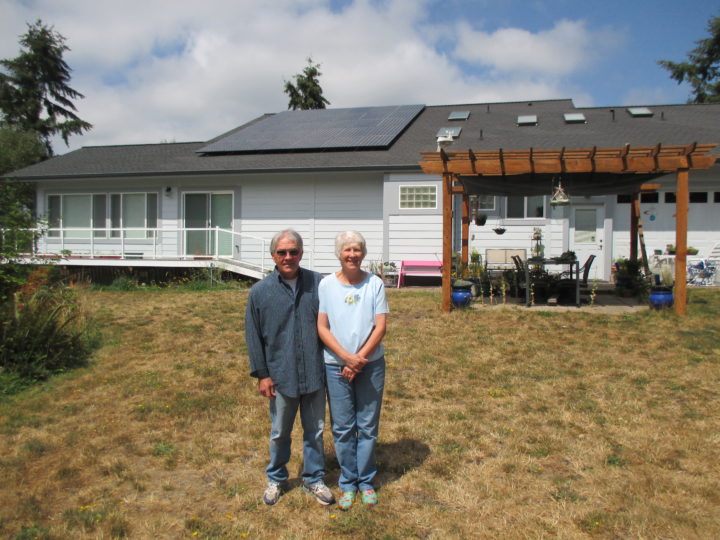Solar is Sexy, Financing Is Not Sexy
Unless you are in the business of helping people put a solar array on their homes, you might not think much about some of the other things that have to line up for these projects to make sense. The technology itself is fairly straightforward, but some other significant factors that support these projects are:
- Utility policy and the state laws that allow or prevent obstruction of solar installation
- Natl. Electric Code that supports solar photovoltaic (PV) equipment and provides guidance for safe installations
- Federal tax policy recognizing the value of clean energy
- State laws preventing HOA’s from interfering with the installation of solar
- Sensible loan packages in the case someone needs outside financing
Here in Washington State, we are blessed with a confluence of these factors that all come together making the installation of solar PV relatively attractive for our clients. At this moment I would especially like to give appreciation to two local credit unions for putting together some very low interest energy efficiency financing programs, and the WA State Dept of Commerce, which has implemented a program enabling these loans in partnership with the credit unions.
Until a few years ago, we did not have any attractive credit options to recommend for our clients. The only option our state’s solar industry had was consumer credit along the lines of how you might finance an appliance, perhaps from GE Capital, and those loans were not anything we would ever recommend to our clients. Within the last couple of years however, we now have some excellent low interest rate, long term financing designed specifically for these projects and some of the other incentives they receive.
Both Puget Sound Cooperative Credit Union and Generations Credit Union have received high reviews from our clients that have used these loans. The rates are low and the terms are variable to work with your needs. The key is that each of these loans is supported through a loan guarantee from WA Dept of Commerce, and each is structured to work specifically with other available incentives in order to maximize the economic benefits of the solar electricity being made on your roof.
At this point, nearly 1/3 of our customers are using financing from one of these two credit unions. Puget Sound Cooperative Credit Union has let us know they are writing solar loans for solar at the pace of of $2 Million per month. That is a lot of solar here in Washington State, and that is a big turn on.
So for some of us solar geeks, financing actually can be sexy. Links to each credit union’s program is below.
https://www.psccu.org/Borrow/Energy-Smart-Loans.aspx
https://www.generationscreditunion.com/solar-cash-flow-loan.htm
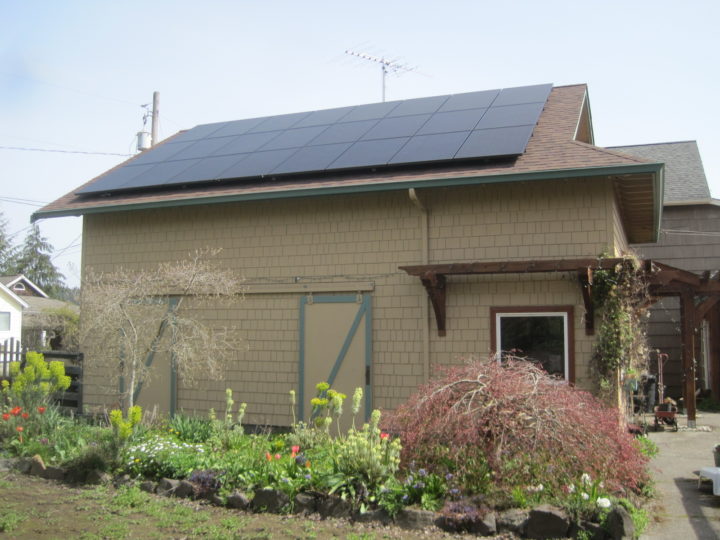
by Andy Cochrane | Jun 7, 2018
As more people purchase the economical Electric Vehicle models that are increasing their range and becoming an obvious choice of new car, we are also getting asked a lot more about using those batteries for your house or also the Vehicle-to-Grid concept (V2G). There have also been several recent articles talking about developments in V2G technology, and the concept is interesting – “as long as I have a 40 kwh lithium battery in my car which is parked in my garage, I think it would be a good to idea use that battery for powering my house.”
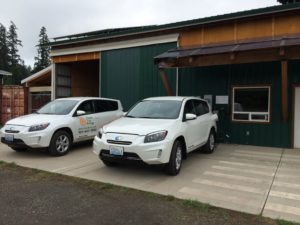
A pair of RAV4 EV’s at Power Trip Energy’s free solar powered EV charging location.
While this sounds good and we look forward to eventually bringing this technology to your home, it is not here now, and may not be here for a long while. In the meantime, your grid-tied solar PV systems will be making clean power and saving you money every month without using your EV’s battery. We just added a second EV to our company’s fleet, a new 2018 Nissan Leaf, which came with 2 years of free electricity when we charge at any EV stations in one of four networks, two of which are common here on in Western Washington – Blink and Charge Point.
Nissan seems to be a leader in V2G innovation in Europe and Japan currently as mentioned in this article from last autumn. https://electrek.co/2017/10/04/nissan-ev-ecosystem-free-power-leaf-vehicle-to-grid/ I notice that the images in most of these articles are still digital mock-ups at this point, not actual installation photos. Also notably, I have not seen recent developments along these lines in the US.
I first saw this concept encouraged by Amory Lovins in the late 1990’s, so we have been looking forward to this functionality for a long time. The concept brings up several questions for me. There are three main uses for large grid-tied residential scale battery banks – one is for emergency back up power in the event of an outage, one is to provide utility dispatchable power for peak load shaving, and the third is for “self-consumption” on a daily basis in order to shift the timing of when a home with grid-tied solar uses that energy.
In regards to the first possible usage, as back-up power during an outage, I would like to see how the controls would work. What if I would rather have a full battery in my car than use that energy for my home? What if I just got home in the evening with a nearly empty car battery when the outage occurs? Ideally the next day would be sunny, and the power from my pv array could both charge my car battery and provide some power for my house. How would I prioritize that energy use – would I rather fully charge my car battery first, then make excess available for home usage? Realistically, I think we are quite a ways from having inverters, chargers, and controls ready to address those questions satisfactorily. However there is probably no technical reason why those could not be solved, though there might be a little complexity on the client side to make certain it works the way you would want.
Regarding the peak load shaving for utilities, this is not something on the horizon at all here in Washington State to my knowledge. There are however several markets where utilities may compensate customers for being able to access their stored energy and use it across large distributed areas in order to prevent the need to fire up a gas “peaker” plant during moments of highest load. This is the case in some markets, where there are commonly peaks on hot weekday afternoons when industry is functioning and also there is a need for air conditioning. In this case, these batteries are not available for emergency back up power. It would be an interesting question as to when I would want to make my car battery (and therefore my driving range) available to the utility, and how much I would let them use, and how much that would be worth to them and me. I think answering these questions is the experimentation being done by Nissan in these projects I have read about in other countries. Again there is no work being done along these lines with V2G in the US of which I am aware.
In the third case, the use case for batteries is a function of the utilility policy that may no longer allow new grid-tied pv systems to feed energy back into the grid (as in Hawaii currently) or rate schedules where there is a strong price signal discouraging customers from sending their solar electricity onto the grid during sunny hours (as in some California markets currently.) We do not have these pricing signals in Washington State currently. These markets are primarily the ones being addressed by the residential-scale wall-mounted “Power Wall” batteries being made by Tesla at the moment, but nobody is actually doing anything beyond thinking about using vehicle batteries for this in the US at this point. There are technical challenges and control system complexities, but I am guessing they will all be solved eventually, though quite a while from now. I look forward to combining these systems with our roof-mounted solar pv systems some day.
The reason why it seems there is no progress on V2G in the US at this point is complex and may be political rather than technical. I sometimes wonder if it is because utilities and oil companies hold greater influence over electrical and building codes in the US than in other countries. Will we see Vehicle to Grid innovation here in the US soon? I don’t know.
Today the price of solar is lower than ever before and we have several excellent state and federal programs to help defray those costs and improve the economics of these upgrades to our clients’ homes. The solar PV arrays we are installing now have 25 year warranties guaranteeing they will still be producing 92% of their originally rated power at 25 years, so there is little doubt that many of the solar pv systems we are installing now will eventually be integrated into storage solutions with wall-mounted batteries and EV batteries that will provide for back-up power and possibly shape the timing of loads that make sense for both our clients and the utilities.
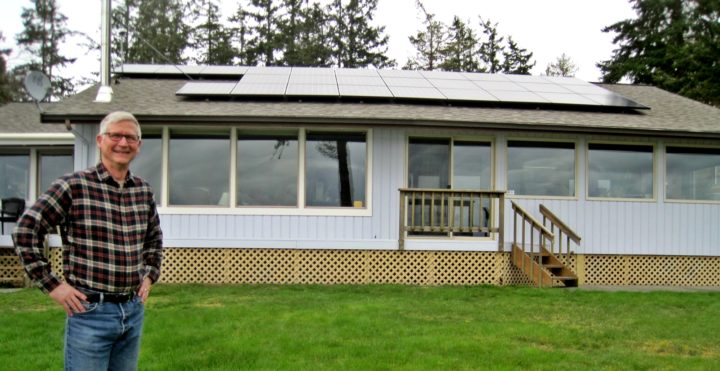
Jefferson County Residence, 9 KW SunPower AC Modules, January 2018
by Andy Cochrane | Apr 17, 2018
On Jan 10th we were surprised to receive a letter from Clallam PUD indicating that on January 8th, the PUD Board of Commissioners resolved to discontinue retail net metering as of February 1st. This action appears to have been taken without notice nor with request for input comment from the public, and the resolution does not appear to be on the agenda for the meeting. http://powertripenergy.com/wp-content/uploads/1-8-18-Commissioners-PreAgenda-FINAL-1.pdf
This means the utility will still allow interconnection of your clean safe solar, but will now be crediting a portion of the solar produced electricity at their claimed wholesale cost rather than crediting solar generators the same rate they charge customers per kilowatt hour (kwh), which is what is referred to as net metering. So for the portion above and beyond a home’s usage during the summer months, the homeowner will be credited at about 3.5 cents / kwh rather than 7 cents / kwh. Existing Net Metering customers will retain their current agreement. This will affect all new Clallam PUD interconnections as of Feb 1st.
The legal basis for this is that the RCW 80.60 only requires that utilities allow net metering in an amount of 0.5% of the 1996 peak loads (the net metering law was passed in 1998.) There is no technical nor economic basis for this threshold, which is much lower than most other states; it is just a relic of the flawed legislative process of the time. This amount has now been exceeded in Clallam PUD so they currently have the legal option to close down new net metering applications, which the commissioners have decided to exercise.
There is currently a bill being considered in Olympia (SB 6081) which would remedy this situation state-wide, and update our 20 year old Net Metering law.
There are three courses of action we currently recommend:
1. If you have been considering installing grid-tied solar pv, order your system now so we can submit your application prior to January 31st, and install your system before this summer.
3. Support Senate Bill 6081, which is currently being considered by the state legislature, and which would eliminate this archaic limitation to the net metering requirements. Learn more here:
http://solarstrongwa.org/
Here are the documents we received on Jan 10th. We currently have no minutes for the Jan 8th meeting nor any record of what was discussed or what basis was used for making this decision.
by Andy Cochrane | Jan 17, 2018
Last month in Bellevue, leaders in the state’s solar industry gathered along with legislators, regulators, and solar advocates for the annual Washington Solar Summit. This year was notable for several reasons including much discussion of the transition from the legacy incentive program to the new and improved incentive program, a review of the status of net metering across the 60+ utility territories in Washington state, and a keynote speech from Gov Inslee, a supporter of renewable energy during his entire political career.
The state’s small-scale renewable energy incentive program, originally passed in 2005, has been successful in raising awareness, and recognizing the benefits of distributed generation, but had reached the end of its useful life as a program due to its 2020 sunset date. The new incentive program will provide certainty for another few years while keeping the state’s overall investment low and making sure the state is getting the best results for its support of the industry. The downside to the new program is that it appears the overall caps are low enough that the local solar industry will experience two very busy years until the program closes. When programs open and close and dramatically affect demand suddenly, it presents a challenge to businesses that serve that market. We are happy to forecast however that the new program could result in an additional 100 solar homes each in Jefferson and Clallam Counties in the next two years.
While the state’s new incentive programs are encouraging another wave of distributed solar installations, the state’s net metering law is outdated and does not provide the necessary support for the potential new projects which have now been incentivized. Updating the state’s Net Energy Metering laws is the most important issue the solar industry faces, and with over 60 utilities statewide now left to develop their own policies, the utility industry would also benefit from stronger state guidance.
Gov. Inslee spoke about the importance of renewable energy from a climate change perspective, but also highlighted the economic benefits to the state of being a leader in clean energy, in terms of jobs and high tech facilities like the REC Silicon facility in Moses Lake. While federal policy remains unpredictable, at the state level, Gov Inslee has provided leadership on this issue through partnership with several other states in the United States Climate Alliance. More information is available here: https://en.wikipedia.org/wiki/United_States_Climate_Alliance
With the brief moment in which I had the Governor’s ear, I expressed support for carbon pricing as a way to achieve greenhouse gas reduction targets. It makes economic sense to me to tax things we wish to discourage, like carbon emissions, rather than taxing things we want to encourage, like individual income and home ownership.
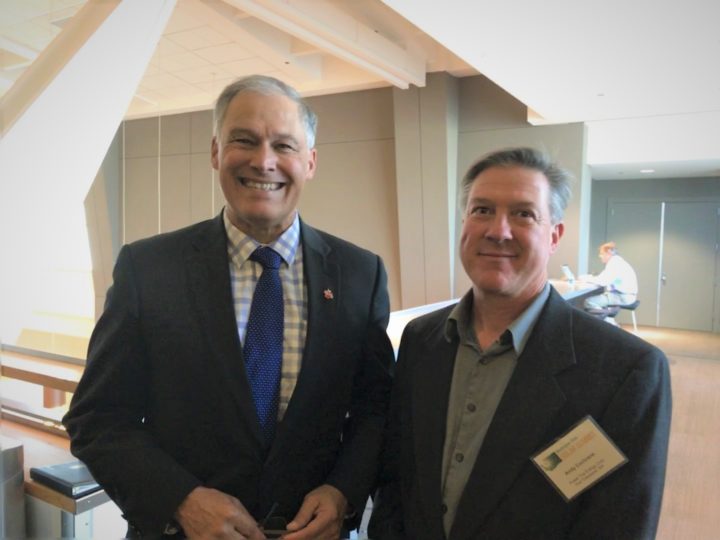
by Andy Cochrane | Nov 21, 2017
Solar Agent
Be an agent of solar change and help clients navigate their choices to determine whether and how to put grid-tied pv on their house.
You will have technical sales expertise, a driver’s license and clean driving record, and a desire to help our clients understand and make choices to harvest solar energy on their homes and businesses. You will be joining a small company and working alongside the owners. You will professionally represent us with integrity, positive attitude, and excellent communications skills utilized for coordinating with the public, our clients, utilities and government regulators, and other departments within the company. You will be brutally honest, have excellent math and writing skills, be in prime physical shape, and comfortable using a 32’ extension ladder to reach second story roofs. You will use company laptop and vehicle. You will live in or around Port Townsend.
Specific tasks include:
- educating and qualifying customers over the phone and in person
- site analysis using ladder, hand tools, compass, camera, and cool high-tech shade analysis tools
- conceptual design and communication of financial cost, incentives, savings, and financing options during site visit
- detailed system design including performance estimates, requires good math skills including trigonometry and basic understanding of electricity and physics
- preparation of proposals, contracts using Word, Excel, SketchUp and solar design software
- answering questions in order to close the sales
- creating detailed project binders for the installation crew, including basic electrical calculations and one-line drawings
- creating basic permit applications using manufacturer’s engineered specs, shepherding applications through various jurisdictions
Additional marketing tasks may include graphic design of marketing materials, writing press releases, event coordination, and public speaking at indoor and outdoor events.
We provide a competitive compensation and benefits package including health insurance, phone stipend, paid sick and vacation time, paid and unpaid holidays throughout the year, quarterly bonuses based on profitability, 3% company IRA matching contribution, and continuing education funding.
Send resume and brief statement of your thoughts regarding renewable energy and grid-tied pv.
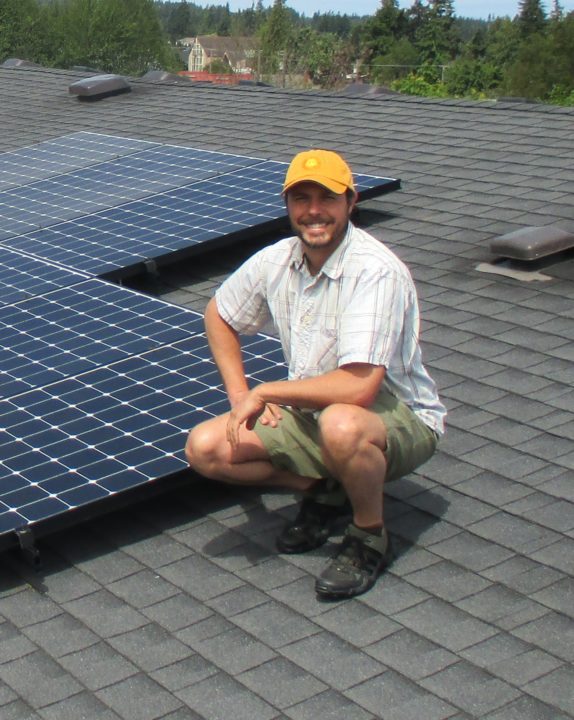
Typical Happy Solar Agent In the Field
by Andy Cochrane | Aug 2, 2017
The annual Washington solar production incentive payments are based on the fiscal year from July 1 – June 30, so everybody with a grid-tied pv system is about to read their meters for the 2016/2017 year.
You will get a letter from your utility containing a form similar to the one below. If you are a PSE customer, the form will be filled out for you. We are not certain what the Jefferson and Clallam PUD’s are planning this year. We have highlighted some of the important fields.
The main thing you want to bear in mind is to go read your production meter on June 30. Even if you are in PSE territory and they are going to read your meter and provide the information for you, we recommend reading your meter yourself at least annually. Then you will want to compare that figure with last year’s June 30 reading in order to get your annual production figure for this year. You will also be able to copy your DOR Tax Reporting Number from the top of last year’s form.
Unless you are among the minority of our clients who have the Made in Washington PV modules, you will use the field highlighted to report your total kilowatt-hours for the year. Although the base rate is stated as $0.15, all utilities in which we operate are or will be seriously pro-rating this base rate due to the fact that the applications are now exceeding the available incentive pool, of 0.5% of taxable utility revenues.
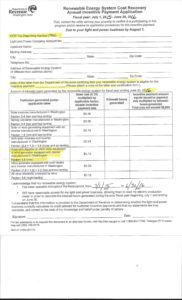
by Andy Cochrane | Jul 5, 2017
In the early morning Saturday July 1st, a couple of hours after passing the budget, both houses of the state legislature passed SB 5939, which will raise the caps on the currently over-subscribed solar production incentive, lowering incentive rates overall, but providing longer term certainty. There are several other aspects of this bill, which should be signed into law by Gov. Inslee soon. Until the Governor signs it, and even during the administrative rule-making process, anything can happen, however this looks as certain as things can get. Overall this is a major improvement over the existing program and great news for people who install grid-tied solar PV in the next couple of years. Lower rates but with a longer guaranteed result are helpful to everyone, however there are challenges in this new program.
The solar industry in Washington has been working with the legislature at least four years to implement many of these changes. A brief initial summary is in order:
- For new projects, incentive payments will be paid at a guaranteed rate for 8 years, rate determined by the date of commissioning as per the following table (Sec 5 (10))
- Sales tax exemption expires Sept 30, 2017 (Sec 15 3))
- Incentive cap per utility increases from 0.5% to 1.5% of the utility’s taxable power sales (Sec 4(2))
- Responsibility for administration of the program is being moved from Dept of Revenue to WSU Energy Extension (Sec 3 (9))
- People with existing systems may install additional systems and enroll them in the new program (Sec 6 (3)(b))
- People enrolled in the existing program will be able to re-enroll to have their rates stabilized at the 2015-2016 rates until June 30, 2020. (Sec 3 (10))
| Fiscal Year Certified |
Base Rate
(Residential, ie <12 KW) |
Base Rate
(Commercial, ie >12 KW) |
Made in WA Bonus |
| 2018 |
$0.16 |
$0.06 |
$0.05 |
| 2019 |
$0.14 |
$0.04 |
$0.04 |
| 2020 |
$0.12 |
$0.02 |
$0.03 |
| 2021 |
$0.10 |
$0.02 |
$0.02 |
One important take-away is that there is a golden moment right now. It appears people who install between now and Sept 30 will not pay sales tax, but will still get the benefit of the 8 year guaranteed rates. Meaning…if installing solar pv on your home or business has been something you have been considering, and that you would like to do “some day”, there has never been a better time than right now.
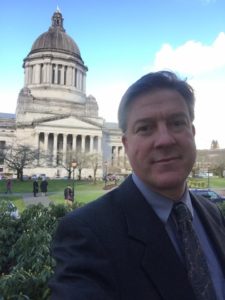
After meeting with representatives, Feb 2017

With Jeremy Smithson, March 2015, after testifying regarding net metering and renewable energy incentives’ effect on small businesses.
by Andy Cochrane | Jul 5, 2017
Our state’s Net Metering law was originally passed in 1998. All utilities in Washington State are required to allow their customers to install solar photovoltaic (or PV for short) renewable energy systems and provide “net metering” to their customers. Net metering allows you to use the solar electricity your system is generating and to sell any surplus to the electrical utility at the same retail rate they charge you for their electricity. Net metering regulations have dramatically improved the average person’s ability to create and use their own solar power. Here in the northwest our peak energy usage is typically during the wintertime when the days are shortest, while our peak sunny days and highest solar production occur in the summertime. With net metering, it doesn’t matter. Net metering allows us to earn credits on our monthly utility bills in the summertime with our grid tied solar PV system and use those credits in the fall and winter as the days get shorter and our energy needs start rising again. During the winter when your solar PV array isn’t producing as much power as your home or business requires, the grid provides steady, reliable power.
In this way, we are using the grid as a “virtual battery.” This virtual battery has many advantages over having an actual physical chemical battery in your home.
- It is infinitely sized, at least practically infinite relative to our 5-25 KW residential grid-tied pv system. Our solar electricity will never “fill” the grid, unlike an actual off-grid battery bank which may be at full charge early on a summer morning, not giving us anywhere to store our summer day’s energy unless we make certain to use the energy at the same rate at which it is being produced.
- It is 100% efficient. Energy stored in the form of a kwh (kilowatt-hour) credit on your meter is later used, and because there is no conversion from electrical to chemical energy and back, there is no loss due to inefficiency, which may be as low as 75% in some battery systems.
- We can seasonally store energy. There is no loss of energy over time when it is stored as a credit on your meter. So you can use summertime energy in the wintertime when you need it and your array is not producing as much power.
- You already pay a small monthly fee for the use of the grid. The grid construction and maintenance is a socialized cost shared by all utility customers, you will see you monthly service charge on your existing bill. This flat fee ranges from about $12 per month in progressive utilites, up to nearly $30 per month in utilities that keep kwh rates low by using high flat fees.
While in some states, there have been political battles over net metering, but there is no conversation along these lines in Olympia and it seems Net Metering is the law of the land for good.
Here is the underlying RCW 80.60: http://app.leg.wa.gov/rcw/default.aspx?cite=80.60
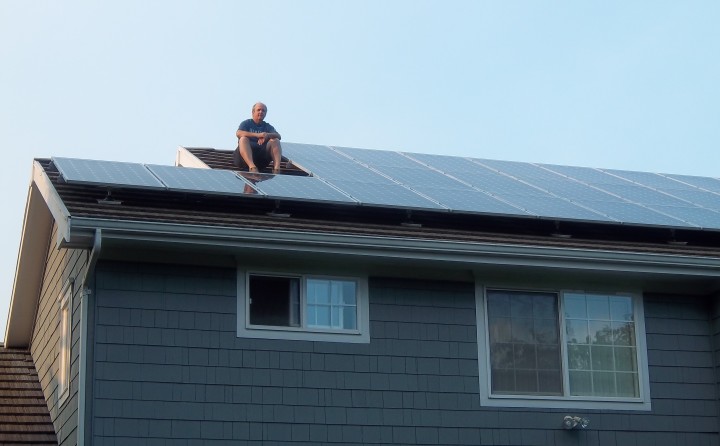
by Andy Cochrane | Jun 27, 2017
This is a good question, and one that is commonly asked.
Yes, solar power works just very well in our area of Washington State. Here on the north Olympic and Kitsap Peninsulas we average approximately 3.5 hours of full sun per day. That is about 70% of the solar resources of southern California. However, unlike southern California most of our sunshine arrives between March and September when our electricity needs are low, especially for homes designed to not require air conditioning. If your system is tied to the grid, your summertime excess electricity generation can go back onto the grid, and may be used by your neighbor or effectively by Californians during their peak energy usage. You will get a a credit for every kwh you put onto the grid, and you will use those credits later, perhaps that night, perhaps not until winter.
For another comparison, western Washington on average receives more yearly sunshine than does Germany on average. This is significant because for the 10 years 2005 – 2014, Germany led the world in the number of installed solar modules with over 50% of the world’s deployed solar modules during that time (China has now become the world’s top installer of solar pv.) If Germany can effectively utilize solar power so can western Washington.
We see an annual variation of up to 15% even among the same solar pv systems due to weather variation of one year to the next. The summers are predictably good, the winters are predictably winter, and we see the variation mostly in the spring – some springs are notably sunny and some are cloudier extensions of winter. Depending on exactly where you live on the Peninsula, if your home is unshaded, you can count of seeing 1000-1200 kwh/year-KW.

Murney Residence
by Andy Cochrane | Jun 13, 2017
David & Barbara Heid asked us to install a 12.4 KW Solar PV system on their new home. They felt compelled to provide the following review based on their experience so far.
—
Power Trip (PT) was instrumental in building our new “green” house. Several years ago PT was asked to survey our possible building site for potential solar energy capture. Their survey reported that the site had positive solar potential. That survey began our strong relationship with PT.
PT was with us from the beginning of our newhome. PT determined the compass orientation of the house foundation that would place the roof line for the greatest capture of solar energy. PT also designed the angle (slope) and size of the roof for placement of solar panels. PT also helped in our selection of the metal roof style that enhanced panel placement without having to penetrate the roof for panel anchorage.
Our “green” home is installed with a ductless heat pump for household heat, a ‘heat-pump’ hot water heater, and all lighting is LED. The house is insulated beyond county code requirements.
PT installed our solar panels on January 5, 2017. In addition to the panels, an EV (electric vehicle) charger station was installed. On April 28th , an all electric Chevrolet Bolt was purchased.
Today after 129 days since the installation of the solar panels, data collected shows that the ave daily energy use for the house is 32.87 kWh. So far, the ave daily Solar energy production is 32.07 kWh with a result of 97.57% of the daily household electrical use being supplied from Power Trip installed solar panels (32.07kWh/32.87kWh). The total household use of electricity includes the kWh used to charge the Bolt. The Bolt has been driven over 2000 miles since its purchase and it has been charged at our new home only.
Also, our PUD electric bills for March and April were only for the monthly $14.50 base fee that is charged to each electric bill. No charges were made for electricity since no electricity was delivered. In addition, the May PUD electric bill states that 396 kWh have been added to our banked usage balance.
We look forward to the days ahead when the ‘2017 spring rain season’ is replaced with some long days of sunshine and ‘banking’ energy for later winter days. Also with new batteries being developed, our future may include an ‘on site’ energy storage system.
Can we recommend Power Trip Energy for solar planning and installation? YOU BET!
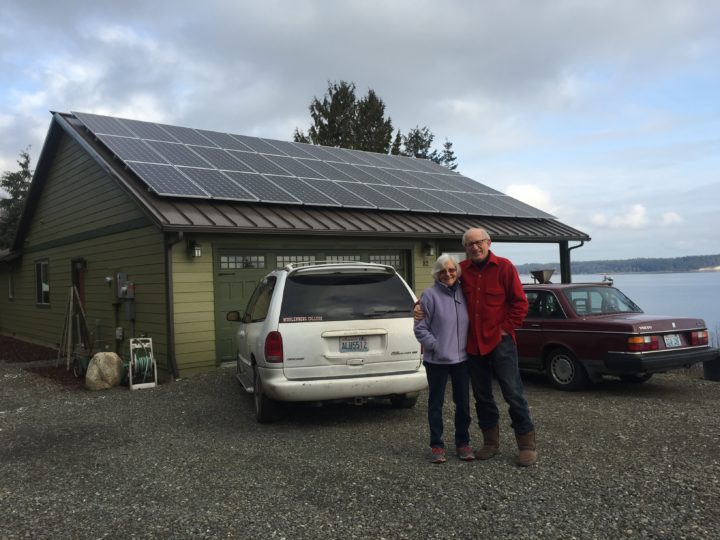
Heid Residence, 12.4 KW, Port Ludlow, Feb 2017
by Andy Cochrane | May 23, 2017



